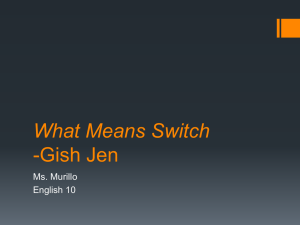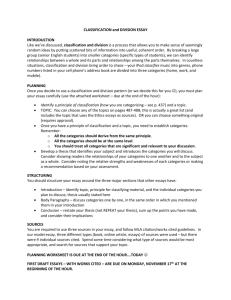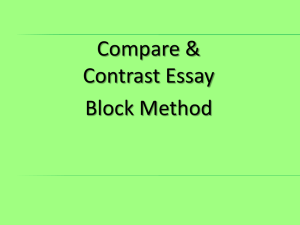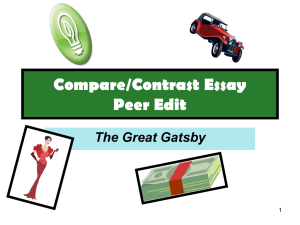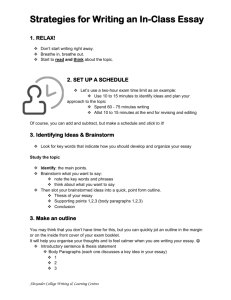A.S.P.I.R.E. Essay Roaring 1920s VERSUS the Great Depression of
advertisement
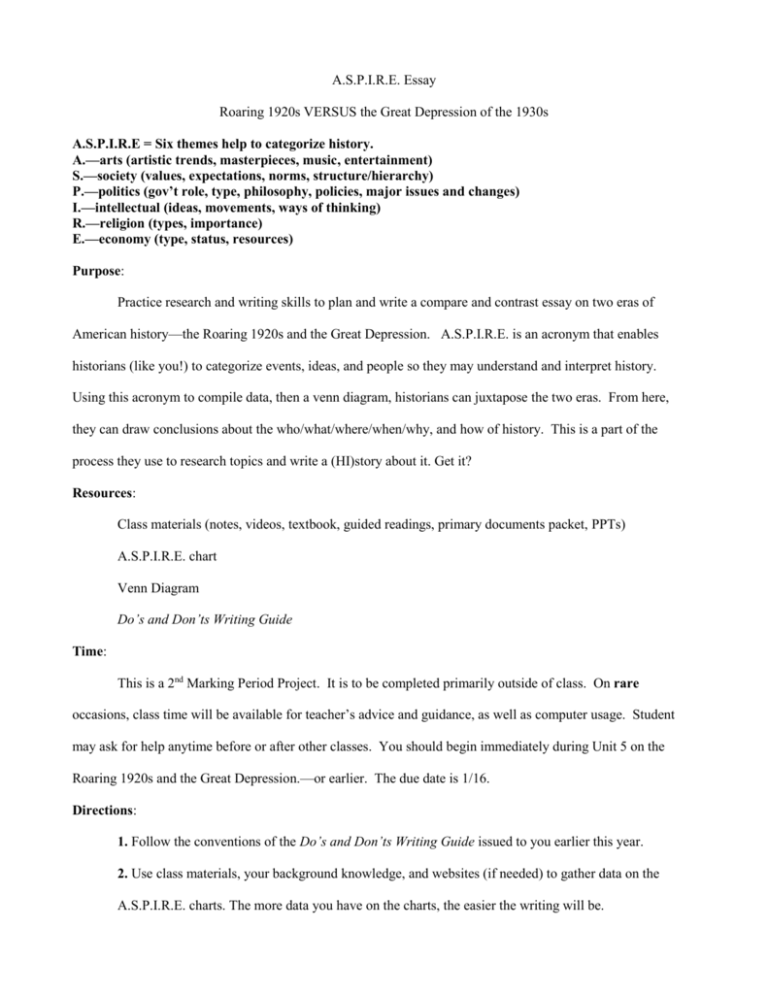
A.S.P.I.R.E. Essay Roaring 1920s VERSUS the Great Depression of the 1930s A.S.P.I.R.E = Six themes help to categorize history. A.—arts (artistic trends, masterpieces, music, entertainment) S.—society (values, expectations, norms, structure/hierarchy) P.—politics (gov’t role, type, philosophy, policies, major issues and changes) I.—intellectual (ideas, movements, ways of thinking) R.—religion (types, importance) E.—economy (type, status, resources) Purpose: Practice research and writing skills to plan and write a compare and contrast essay on two eras of American history—the Roaring 1920s and the Great Depression. A.S.P.I.R.E. is an acronym that enables historians (like you!) to categorize events, ideas, and people so they may understand and interpret history. Using this acronym to compile data, then a venn diagram, historians can juxtapose the two eras. From here, they can draw conclusions about the who/what/where/when/why, and how of history. This is a part of the process they use to research topics and write a (HI)story about it. Get it? Resources: Class materials (notes, videos, textbook, guided readings, primary documents packet, PPTs) A.S.P.I.R.E. chart Venn Diagram Do’s and Don’ts Writing Guide Time: This is a 2nd Marking Period Project. It is to be completed primarily outside of class. On rare occasions, class time will be available for teacher’s advice and guidance, as well as computer usage. Student may ask for help anytime before or after other classes. You should begin immediately during Unit 5 on the Roaring 1920s and the Great Depression.—or earlier. The due date is 1/16. Directions: 1. Follow the conventions of the Do’s and Don’ts Writing Guide issued to you earlier this year. 2. Use class materials, your background knowledge, and websites (if needed) to gather data on the A.S.P.I.R.E. charts. The more data you have on the charts, the easier the writing will be. 3. Transfer the data to a venn diagram labeled as the Roaring 1920s---Great Depression. 4. Make a conclusion based on the facts. What is your thesis statement (i.e. main argument written in a sentence that answers the question: ‘Are the two eras more similar or different?’) Do you have evidence to prove your thesis? If yes, then continue to step 5. If no, then you have the wrong thesis statement. Reconsider the facts and make a new thesis statement. The thesis statement should be underlined on the final essay. 5. Outline an introduction, body, and conclusion. You will turn this in with the final version. 6. Add details (from your venn diagram) to the outline. If you take direct quotes or ideas from other sources, cite them in “Works Cited” page attached on the back of your final essay. 7. Write. Re-write. Write. Re-write. Writing is a process. Do not be satisfied with your first draft. 8. Have a parent or peer review it based on the rubric below. Handwrite his or her name on the bottom of the Works Cited page or the last page of your final essay. 9. No Title Page and no page limit. On page one, in the top left hand corner, put your name, my name, the class period, and due date of 1/16. Center your CREATIVE title above the introduction. All double spaced, size 12 font, Times New Roman ONLY. Follow the Do’s and Don’ts Writing Guide. Rubric: FOCUS’D 15pts F Focused on A.S.P.I.R.E. Thesis is underlined. ASPIRE is addressed. 15pts O Organized Introduction, body, conclusion 15pts C Conventions Proper grammar, spelling, paragraph form, transitional phrases, and the Do’s/Don’ts Writing Guide are all used 15pts U Understanding is Clear Writer’s comprehension is clear and thorough. Obvious that the write took time, concern, and effort to craft the essay 15pts S Style Proper sentence structure, best word choice, examples are used to prove your thesis, when read--‘it flows’ 25pts ‘D Diagrams are attached Two A.S.P.I.R.E. charts, venn diagram, and outline are used and attached



